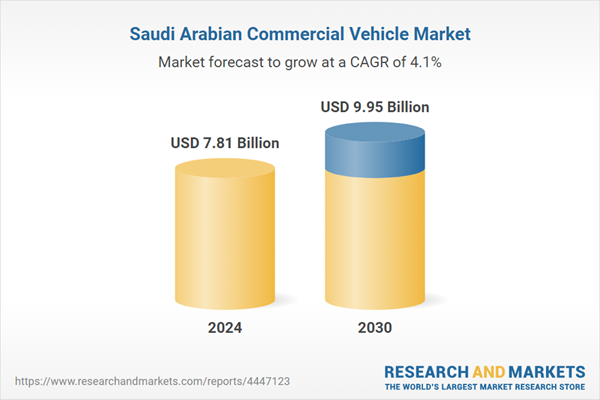Speak directly to the analyst to clarify any post sales queries you may have.
10% Free customizationThis report comes with 10% free customization, enabling you to add data that meets your specific business needs.
Market Drivers
Expansion of Logistics and E-Commerce Operations
The rapid growth of e-commerce and the evolution of logistics networks are significantly boosting demand for commercial vehicles. As online retail continues to grow, companies require more delivery vans, trucks, and last-mile transport solutions to meet rising customer expectations for fast and reliable delivery. Logistics companies are increasing their vehicle fleets to ensure efficient warehousing, inventory movement, and distribution across vast geographic areas. This surge in transportation needs directly correlates with the demand for medium and heavy-duty commercial vehicles, especially those with better load handling and fuel efficiency. Growth in cross-sector logistics partnerships is also prompting fleet expansions and upgrades.Companies are optimizing delivery routes and investing in modern, connected vehicles that improve delivery timelines and service consistency. For instance, In Q4 2024, Saudi Arabia’s e-commerce sector recorded a 10% year-on-year growth, reaching 40,953 registered businesses, with Riyadh leading at 16,834. The logistics sector surged 82% in new records, totaling 16,561, while application development saw a 36% rise to 15,775 registrations. The fintech sector also grew 12% with 3,152 new records. These figures align with Saudi Arabia’s Vision 2030 goals to expand digital commerce, boost online payments to 70%, and raise e-commerce’s share of retail to 80%, reflecting the Kingdom’s broader push toward digital diversification and innovation-led economic growth.
Key Market Challenges
High Initial Acquisition Costs
The upfront cost of commercial vehicles remains a significant barrier for fleet operators and small businesses. Purchasing new trucks, vans, or heavy-duty vehicles involves a considerable capital investment, especially for models equipped with advanced technology and safety features. While these modern vehicles offer long-term savings in fuel and maintenance, the high initial price tag can deter many buyers from upgrading or expanding their fleets. Financing options often carry restrictive terms or require substantial down payments, which further complicates access for smaller players. Businesses may delay procurement decisions or opt for used vehicles that do not meet current performance or environmental standards. This financial strain becomes even more critical in cost-sensitive sectors like agriculture, construction, and retail logistics, where operating margins are often tight.Key Market Trends
Integration of Telematics and Smart Fleet Management
Fleet operators are increasingly adopting telematics systems and smart fleet management technologies to enhance operational control, reduce costs, and improve vehicle utilization. These digital solutions offer real-time insights into vehicle location, fuel usage, engine performance, driver behavior, and maintenance schedules. By integrating telematics into their operations, companies can optimize delivery routes, prevent unauthorized vehicle use, and reduce idle times.Predictive maintenance capabilities help identify potential mechanical issues before they become serious problems, lowering repair costs and reducing downtime. Driver behavior monitoring contributes to improved road safety and helps reduce insurance premiums. Cloud-based platforms enable centralized fleet tracking and analysis, making it easier for businesses to scale operations across multiple regions. Telematics also support regulatory compliance by providing automated reporting and vehicle diagnostics aligned with safety standards.
Key Market Players
- Toyota Motors Corporation
- Isuzu Motors Saudi Arabia Company Limited
- Mitsubishi Fuso Truck and Bus Corporation
- Hino Motors Limited
- Ford Motor Company
- Hyundai Motor Company
- MAN Truck and Bus Middle East
- Volvo Trucks Corporation and Volvo Bus
- Mercedes-Benz KSA Commercial Vehicles
- Ashok Leyland
Report Scope:
In this report, the Saudi Arabia Commercial Vehicle Market has been segmented into the following categories, in addition to the industry trends which have also been detailed below:Saudi Arabia Commercial Vehicle Market, By Propulsion:
- ICE
- Electric
- Hybrid
Saudi Arabia Commercial Vehicle Market, By Vehicle Type:
- Light Commercial Vehicle
- Medium Commercial Vehicle
- Heavy Commercial Vehicle
Saudi Arabia Commercial Vehicle Market, By Region:
- Northern & Central
- Western
- Southern
- Eastern
Competitive Landscape
Company Profiles: Detailed analysis of the major companies present in the Saudi Arabia Commercial Vehicle Market.Available Customizations:
With the given market data, the publisher offers customizations according to the company’s specific needs. The following customization options are available for the report.Company Information
- Detailed analysis and profiling of additional market players (up to five).
This product will be delivered within 1-3 business days.
Table of Contents
Companies Mentioned
- Toyota Motors Corporation
- Isuzu Motors Saudi Arabia Company Limited
- Mitsubishi Fuso Truck and Bus Corporation
- Hino Motors Limited
- Ford Motor Company
- Hyundai Motor Company
- MAN Truck and Bus Middle East
- Volvo Trucks Corporation and Volvo Bus
- Mercedes-Benz KSA Commercial Vehicles
- Ashok Leyland
Table Information
| Report Attribute | Details |
|---|---|
| No. of Pages | 85 |
| Published | July 2025 |
| Forecast Period | 2024 - 2030 |
| Estimated Market Value ( USD | $ 7.81 Billion |
| Forecasted Market Value ( USD | $ 9.95 Billion |
| Compound Annual Growth Rate | 4.1% |
| Regions Covered | Saudi Arabia |
| No. of Companies Mentioned | 10 |









